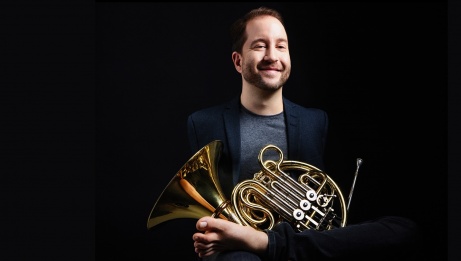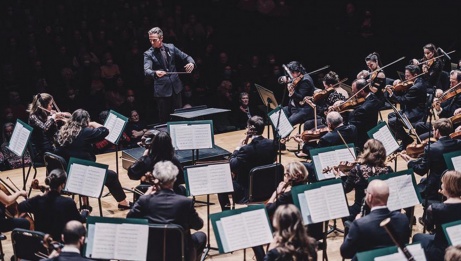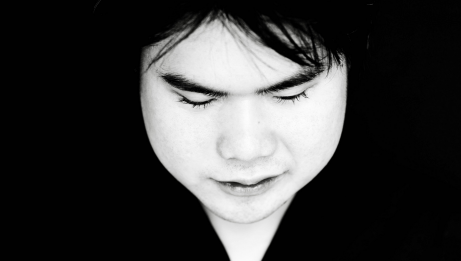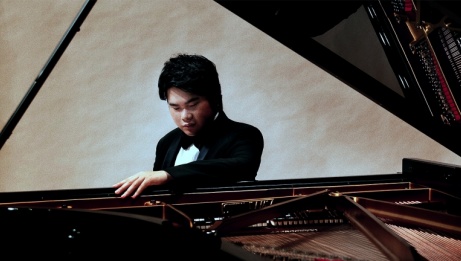
Mighty River
with the NAC Orchestra
Love live performances? Make a tax deductible donation Donate today
Watch more in this series
- #CanadaPerforms
- NAC Orchestra
Feb 27, 2021 - 8 PM EST
The NAC Orchestra conducted by Music Director Alexander Shelley goes technicolour with this program of exciting contemporary works by Anna Clyne, Zosha Di Castri, and Errollyn Wallen. Interspersed between them are modern showpieces by Ravel and Milhaud, featuring two talents from CBC Music’s 2020 classical “30 under 30” list: violinist Marie Bégin and saxophonist Jennifer Tran.
Anna Clyne’s This Midnight Hour (2015) opens this concert with a goose bump–inducing adventure of orchestral sound and colour. Its ferocious beginning, according to Clyne, was “inspired by the character and power of the lower strings of the Orchestre national d’île de France”, who commissioned the piece. From there, she notes, the music draws inspiration from two poems—one by Juan Ramón Jiménez, the other by Charles Baudelaire—that are intended “to evoke a visual journey for the listener” (see below for the texts). We first follow Jiménez’s running woman, headlong and blindly through the music’s twists and turns, riding the darting, rapid motives and the constant and extreme shifts in instrumental registers, textures, and dynamics. Halfway through the work, the melody of Baudelaire’s melancholy waltz bursts through, played “soaring and passionately” by the violas. Soon, however, it disintegrates into the earlier anxieties of the first part; they nearly overwhelm, but are eventually soothed, giving way to a tender orchestral reflection on the waltz theme…before ending with one final surprise.
Marie Bégin takes centre-stage next, as the soloist in Maurice Ravel’s Tzigane (1924). The composer had written it for the Hungarian virtuoso violinist Jelly d’Arányi, whom he saw perform at a London concert after which he requested she play Romani tunes for him late into the night. Inspired by the music she played as well as her technical prowess on the instrument, Ravel created this “concert rhapsody” that draws on various styles of folk music, including Romani and Hungarian, as well as those in a repertoire of violin showpieces by composers such as Pablo de Sarasate and Niccolò Paganini. Composed initially for violin and piano or luthéal (a mechanical attachment for the piano that makes it sound like a cimbalom), the version you’ll hear tonight is with Ravel’s orchestration.
Tzigane begins with a long improvisatory introduction, intense and brooding (it’s nearly half the work’s length). After an otherworldly transition with harp, the violin, now with the orchestra, embarks on two sets of theme and variations. The first is based on a mysterious, folk-like theme from the introduction, on which the violinist cycles through displays of virtuosic techniques with each iteration—harmonics, left-hand pizzicato, double stops, trills. A grandiose melody then sets the stage for the second set of variations based on a dance-like figure. It gradually picks up momentum, whirling faster and faster to the piece’s close.
Like Clyne’s This Midnight Hour, Zosha Di Castri’s Cortège (2010) has a poetic basis. As she describes it, in her own note to the piece, “the idea of a strange procession, a relentless succession of people and sounds…stemmed from a few lines from [Constantine P.] Cavafy’s ‘The God Abandons Antony’ (referencing Plutarch’s story of when Marcus Antonius was besieged in Alexandria by Octavian), and Leonard Cohen’s subsequent adaptation of this poem in the song ‘Alexandra Leaving’.” A “heavy chord” launches Cortège, after which the work progresses in block-like sections, each delineated by the periodic return of the chord, which acts “as a pivot-point between other material.” The intended effect is that of a “rich sonic patchwork”, with the contrasting segments consisting of highly textured “night” music, achieved via techniques such as snap-plucked strings, buzzing tremolos, glissandos. There is an ominous edge to the mood; in the composer’s words, it is “like the perspective of someone observing a parade from a window above, [with] a melancholy awareness of the fleeting nature of the passing revelry. It is the music of impending loss, the night before the city falls into enemy hands or the evening before a lover leaves for good.”
From Cortège’s soundscape of twilight unrest, we are suddenly thrust into one of jaunty optimism in Darius Milhaud’s Scaramouche (1937), in his arrangement for alto saxophone, played tonight by Jennifer Tran, and orchestra. The suite’s contents are derived from incidental music Milhaud had previously composed for theatrical productions: to Molière/Charles Vildrac’s Le médecin volant for the outer movements; and the overture’s theme from his score to Jules Supervielle’s play Bolivar for the middle movement. “Vif” begins with the solo saxophone playing a bustling tune, jostled by syncopations along the way. A contrasting march-like theme of child-like quality follows; the saxophone later adds virtuosic flourishes to it before tumbling back into the opening music. The second movement features two principal ideas: first, a gently rocking theme played by the saxophone over slow dotted rhythms in the orchestra, after which the phrases of a graceful, more flowing melody are traded back and forth between soloist and instruments in the ensemble. These two themes are later combined simultaneously, after a barcarolle-like central section. In “Brasiliera”, the saxophone may be the one with the tune, but it’s the orchestra that is the life of this samba dance party.
Continuing in this hopeful vein, the concert concludes with Errollyn Wallen’s Mighty River (2007), a celebration of humans’ ceaseless pursuit of freedom. “It is an innate human instinct to be free,” she noted in a 2017 interview about the work, “just as it is a law of nature that the river should rush headlong to the sea. That is the concept behind Mighty River, which is composed in one single movement.” Commissioned by the Rector and PPC of Holy Trinity Clapham Common and Reverend John Wates to mark the bicentenary of the Abolition of the Slave Trade Act in the United Kingdom, the work combines contemporary composition techniques with spirituals. Wallen’s incorporation of the latter underscores the shared history of slavery in the UK and the US, for spirituals were initially introduced to the UK by the Fisk Jubilee Singers, an African-American a cappella choir, during their concert tour in 1873.
Mighty River begins with solo horn intoning the melody of the hymn “Amazing Grace” and then moves into pulsating chords in the strings, evoking the river’s unceasing forward progress. Over this minimalist backdrop, the woodwinds burble and, gradually, other instruments join the flow, adding wave-like texture and sparkle, as new themes begin to emerge. About midway through the work, there are references to the spirituals “Deep River” and “Go Down Moses”, which eventually lead into a climax. Afterward, the orchestral “river” resumes its course, with “Amazing Grace” played in turn by various instruments; it then continues its way, as if flowing more freely. Near the end, the hymn’s tune makes a final contemplative appearance by the solo horn. In describing Mighty River, Wallen has said “it is as if the perpetual motion of the music, like water, like time, through its sheer momentum, carries with it the cries and echoes of human hearts and voices that are singing out of suffering, repentance, humility, and hope.”
During Wallen’s introduction to Mighty River for this concert, three images appear that deserve highlighting. The first you see of a river is that of the Mississippi River. To African slaves in the USA, the Mississippi River symbolized both bondage and liberty—a route to enslavement but also to freedom. Near the end of the introduction appears another image of a river—the Belize River. Belize, where Wallen was born, has a history of African slavery during the 18th and 19th centuries. In between, you’ll see a 2007 British stamp commemorating the bicentenary of the Abolition of the Slave Trade Act. The stamp features William Wilberforce (1789–1833), the British politician and leader of the movement to abolish the slave trade.
by Dr. Hannah Chan-Hartley
Image credits for Mighty River introduction in order of appearance:
Sir Cam (Errollyn Wallen)
Spudgun67 (Holy Trinity Clapham)
Brian Stansberry (Mississippi River)
Martin Godwin (Errollyn Wallen)
Howard Brown (2007 stamp)
Laslovarga (Belize River)
Cathy Masser (Errollyn Wallen)
- Official car of the NAC Orchestra

- Founding Partner #CanadaPerforms

- Official Rail Partner




















_cropped__square.jpg)






